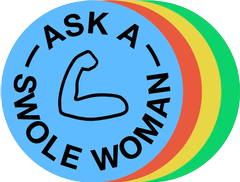Sick of clean eating, perfect gym outfits, and chiseled abs? A Swole Woman is here to help you be healthy, enjoy carbs, and get jacked.
Advertisement
To be clear, this post is not to say everyone should worry about working out right now (they shouldn’t!) but if you have made it a goal to keep working out to maintain strength, or start a new working-out habit with some of your newfound free time, this is all the information I have on smoothing those grooves in this strange and difficult situation.First, I have some quick advice on giving yourself more materials to work with than “a couple dumbbells” or “nothing at all.” Then, I’m going to explain how to structure your working-out pursuit in a way that will make it feel a little less like you’re just uncomfortable flopping around your living room day after day until the end of time. If you want to skip ahead to the workouts, that’s fine, but in a couple weeks when you lose steam, this will be here for you to read.The first question for at-home workouts usually is: How do I get a gym at home, where there currently is no gym? Not having weights at home can, perversely enough, be a barrier to working out, because using more weight in your movements has the very compelling benefit of lowering the number of reps you have to do in order to get close to failure. (You can get a good bodyweight-only workout at home, but it can get tedious. You might be able to do 100 bodyweight squats, but if you can hold something weighing 50 pounds, you might only have to do 5 or 10 reps and can save yourself, by my calculation, one billion years of time. Lifting weights won’t make you bulky).
Advertisement
If you have no conventional weights in your house, and especially not any plates or barbells, you may have also noticed at-home equipment has sold out or gotten incredibly expensive everywhere. This is peak time to get creative.Here is a non-exhaustive list of things that you can use to weight your movements that you almost certainly have some of lying around your house, drawn from my Instagram safaris, my kind followers, and personal experience:
- suitcases, backpacks, or duffel bags filled with books, rocks, cans, or resiliently-packaged beverages
- cast iron cookware, perhaps loaded into the bags above
- boxes or bags of cat litter, sand, cement mix
- buckets, pails, planters filled with water, sand, cement mix
- children
- pets
- your very accommodating partner
- jugs of water
- a case of wine, handled gently
- a rack of beer, handled gently
- the end of a couch (for deadlifting)
Advertisement
This matters because fostering a sense of progress is one of the major things that helps me, and lots of other people, stick with lifting. Lifting the same weights for the same reps and sets in the same movements over and over is incredibly boring, whereas getting stronger and more capable rules. If you’ve ever found yourself getting bored with working out, this might be the reason.Fortunately, there are a number of ways to make your workouts incrementally harder without adding weights, including:
- Adding reps per set
- Adding more sets
- Tempo movements (slowing down parts of the movement to focus on technique and using the right muscles, e.g. doing a pushup for a slow count of three to the bottom of the movement, holding for one count at the bottom, then coming back up for a slow count of three)
- Focusing on technique in general, learning what the right muscles are to drive a movement and trying to use them
- Myo reps or density reps (using shortened periods of rest between sets or intense bursts to increase difficulty)
- “As many reps as possible” (usually done on a final set of a particular movement)
- Using movement progressions (e.g. if you wish to learn to do a pull-up, practicing dead hangs, and then scapular pull-ups when dead hangs become easy, then pull-up negatives when scapular pull-ups become easy, and then regular pull-ups when pull-up negatives become easy)
Advertisement
The best way to make sure this happens is to write down what you’re doing during your workout in a notebook, as well as your goals. This way, you don’t have to try to remember in your brain how many split-squat reps you did last time; you can look back in your notebook, and then try to beat it this time (if you've been eating and sleeping the way you need to for lifting, you should be!). And in the vein of the “movement progressions” point, there are lots of body weight skills you can learn during this time that require no equipment: pistol squats; handstands; pull-ups; even a really proper push-up is hard for most people to do.I try to move things along incrementally whether I’m doing weighted or bodyweight movements, adding reps or sets or tempo movements, and then after a month I reevaluate and see if I’m ready to move up to the next level of difficulty, or ready to add some more books to the Suitcase of Lifting. Related to the bigger picture, I’m not aiming to get stronger in the absolute than I already was pre-isolation, because that would be almost impossible. However, I can build some skills that will help make me overall more balanced.Now for the workouts. This is a pretty small and basic selection, but per above, it’s important to not get stuck on “variety” as the only way to keep working out interesting. I say this as someone who, in her normal life, spends 80% of most of my gym sessions doing the same basic three movements (squat, bench, deadlift): Getting invested in your journey of progress as well as learning to use your body’s muscles and make them stronger will, I swear, keep working out JUST AS interesting as, like, learning a new Zumba dance every time. These are all free, by the way.
Advertisement
Easier, at-home, limited-equipment strength workouts
Advertisement
Mr. and Mrs. Muscle full body workout with dumbbells: This is also a kind of HIIT focused workout, but is constructed of fairly foundational lifting movements. This workout includes low impact and beginner modifications.Bodybuilding.com 15-minute bodyweight strength workout: This workout also includes one or two difficulty modifications you can work through gradually if you’re starting with the easier ones. It doesn’t require any weights, but a lot of the movements can have weight added to them.These workouts are for people who were probably already invested in working out before coronavirus hit, but have become stymied by the sheer logistics of the situation and maybe unsure about whether there’s even any point in working out. It takes less activity to maintain strength than build it (personal trainer Layne Norton, Ph.D., has a nice Instagram post about this), meaning that just because you can’t squat 200 pounds right now with a barbell and plates doesn’t mean you need to give up entirely.r/bodyweightfitness Recommended routine: This is this subreddit’s most tried and true routine. It’s a little longer and more involved than the routines above, but some of the movements can be weighted and it has a ton of progressions that will keep you busy for quite a while.Jeff Nippard's at-home workout: This is a nice set of suggested movements from a guy who is normally a bodybuilder, along with tips about how to modify the movements, how to structure them together, as well as how to adjust nutrition for These Times (keep eating normally!).
Harder at-home, limited-equipment strength workouts
Advertisement
Alan Thrall Coronavirus workout: This is as simple as workouts get, but somewhat requires that you be able to do a fairly hefty number of pull-ups, which might not be all of us. You could sub in another pulling movement, like inverted rows using the underside of a table or pull-up negatives, if you have somewhere to do them. You should never skip your pulling exercises; they are important to your health!Calisthenicmovement at-home workout: This is a workout designed to be done in a hotel room, so it’s very simple, if a little advanced. It uses a lot of movement variations, more than you reasonably need in a single program, but if you like variety or are looking for a larger set of movements to pull inspiration from for working out at home, this is a good video.As a bonus, here is a little routine I made up for myself:It does not matter too much which of these workouts you do. What matters more is staying invested and consistent. The best ways to do that are trying to build some skills and make a little bit of progress with new-to-you movements, and keeping track of that progress so you know where you’re at and where you’re going.While it’s still important to keep pressure on yourself low, giving yourself a goal to focus your energy, even if it’s just working out a certain number of times per week, can be especially motivating and clarifying in a situation where so much feels out of our control.Disclaimer: Casey Johnston is not a doctor, nutritionist, dietitian, personal trainer, physiotherapist, psychotherapist, doctor, or lawyer; she is simply someone who done a lot of, and read a lot about, lifting weights.
You can read past Ask A Swole Woman columns at The Hairpin and at SELF and follow A Swole Woman on Instagram. Got a question for her? Email swole.woman@vice.com .
You can read past Ask A Swole Woman columns at The Hairpin and at SELF and follow A Swole Woman on Instagram. Got a question for her? Email swole.woman@vice.com .

